Life Cycle Assessment of the High Performance Discontinuous Fibre (HiPerDiF) Technology and Its Operation in Various Countries
Abstract
:1. Introduction
2. Background
2.1. The HiPerDiF Technology
2.2. Life Cycle Assessment of FRP Material
- Goal and scope definition: establishing the reason for the study and defining the system under review. Whilst LCAs are based on qualified scientific data, they can have subjective elements, for example, the chosen system boundary, functional unit, or underlying assumptions, which must all be declared before carrying out the data collection phase.
- Inventory analysis: an inventory collates the inputs, outputs, and other environmental aspects within the system boundary for the functional unit. Figure 2 represents a schematic of a composite material product LCA, with materials and energy as inputs and waste materials and emissions as the outputs, collected during the inventory analysis stage for a cradle-to-grave system.
- Impact assessment: the inventory data are weighted and characterised to show the impacts on natural resources, the environment, and human health.
- Interpretation: results are analysed. To ensure meaningful conclusions from LCA, a critical approach to interpreting the results is achieved through a series of checks throughout the assessment.
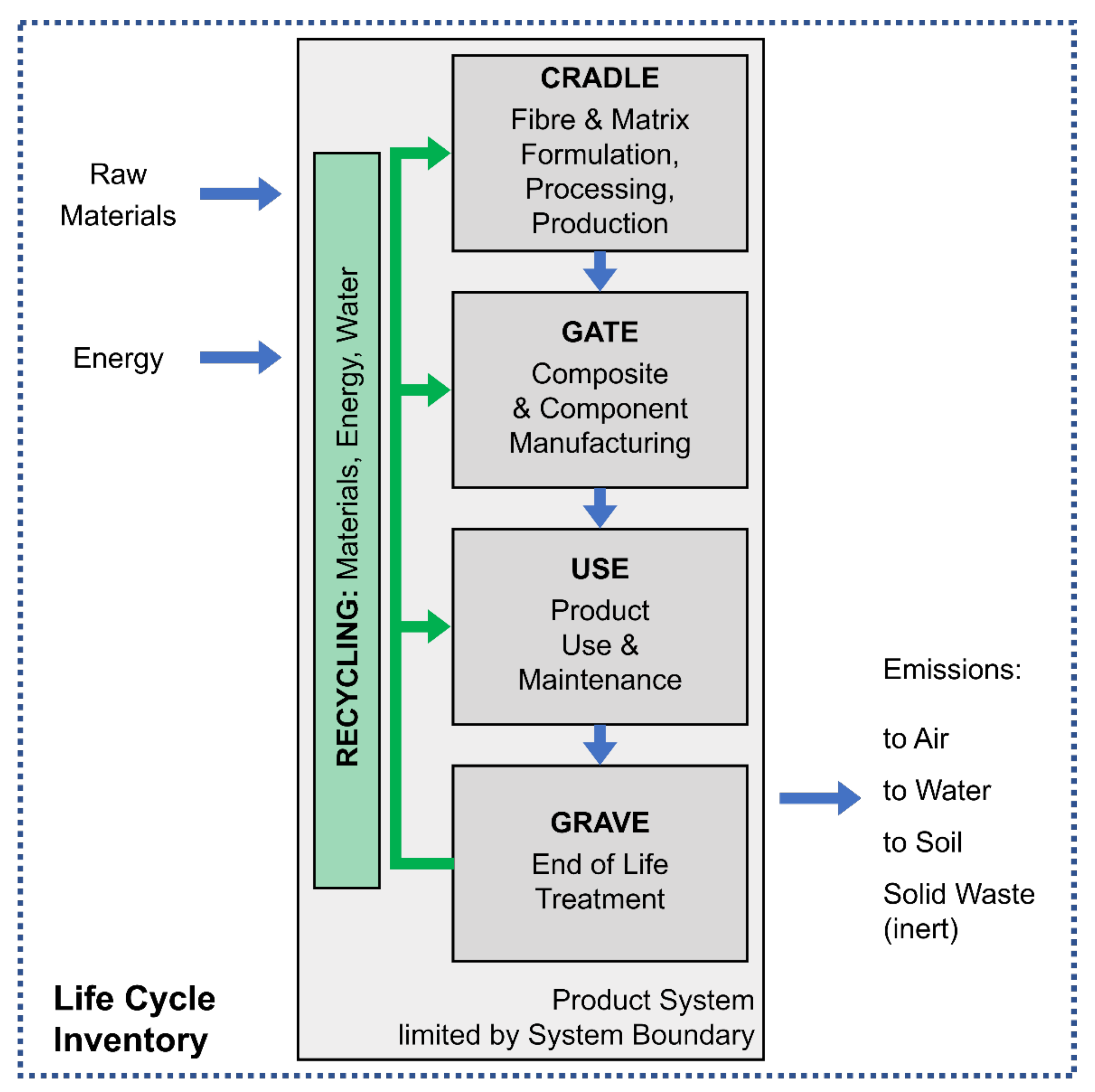
3. The HiPerDiF Study
3.1. Goal and Scope Definition
- Inventory assessment with primary data collection of the PED of appliances used and water required for HiPerDiF technology operation in Bristol, UK. A schematic of the system boundary is presented in Figure 3, indicating the flow of energy through the HiPerDiF prototype during processing. The only inputs to this system that will contribute to the environmental burden are the electrical energy and the water required to run the machine. These data will be used to identify hotspots for future optimisation and will form the baseline against which further impact assessment analyses can be compared. The functional unit (FU) is a quantitative measure of the output of a product or service from the system under investigation [55]. A mass-based FU was selected over a specific composite component so this study can benefit from comparison with future work, which will be the throughput of 1 gramme of aligned discontinuous fibre preform (ADFP).Figure 3. System for LCA study of the HiPerDiF technology lab-scale prototype (HiPerDiF 2G).
- Impact assessment of HiPerDiF machine when operated in various EU location scenarios, specifically chosen to investigate the variability of impact across different sources of electricity generation, which are listed in Table 1. The following locations have been selected:
- Bristol, UK—the location of the current HiPerDiF 2G machine, acting as the control for comparison with the other scenarios.
- Varberg, Sweden (SE)—the CFRP composite manufacturer Carbon & Composites AB [56] is situated on the west coast, south of Gothenburg. Sweden is one of the leading countries in Europe for electricity generated from renewable sources and between 2014 and 2017 65% of its net generating capacity per annum came from renewable sources [57].
- Zurich, Switzerland (CH)—Swiss electricity generation also comes predominantly from renewable sources, at 77% of total net generation capacity. However, Switzerland incorporates a vastly different wastewater management system than Sweden, discussed later in the paper.
- Stade, Germany (DE)—Germany has a similar energy generation mix to the UK, predominantly from fossil fuels, but is further along in the transition towards renewably sourced electricity. It has the largest net generation capacity in solar and wind energy at 20% and 23% of the total, respectively, whereas Sweden and Switzerland source their electricity principally from hydroelectric power (HEP). Hexcel Composites GmbH [58] have a manufacturing site in Stade, conveniently located alongside the River Elbe connecting the North Sea with Hamburg harbour. The CU Nord Recycling Centre [59] is also located in Stade, indicating that if the HiPerDiF 2G machine were to be located in that region there would be few burdens associated with material transportation from the reclamation site.
- Roussillon, France (FR)—72% of France’s total electricity generation was sourced from nuclear power in 2017 [57]; France has the largest dependence on nuclear energy in the world. Opened in 2018, the Hexcel Roussillon [60] plant is their main production site for polyacrylonitrile (PAN), the carbon fibre precursor, and CF for aerospace CFRP composites.Table 1. Net electrical generation capacity and energy source breakdown as a percentage of the total for selected European countries from 2014–2017 [57].Table 1. Net electrical generation capacity and energy source breakdown as a percentage of the total for selected European countries from 2014–2017 [57].
Energy Source (as a Percentage of the Total) UK SE CH DE FR Fossil fuels 56 11 <1 42 17 Nuclear 11 23 19 5 49 Other non-renewable - <1 2 4 - Non-renewable total 67 35 22 51 66 Wind 15 16 <1 23 9 Solar 12 - 7 20 5 Biomass 2 8 1 4 <1 Hydro 4 41 68 2 19 Renewable total 33 65 77 49 34
- The final part of this impact assessment involves expanding the system boundary to incorporate the transport of the recovered fibre material. The two main composite recyclers currently based in Europe were chosen to demonstrate the variation in environmental burdens from alternative modes of transportation:
3.2. Inventory Analysis
- Increase the fibre concentration of the machine such that more aligned fibre preform is manufactured per unit volume of water, and/or
- Adapt the design of the water reclamation process by pumping water back into the high concentration tank and reusing it for the next cycle. This could potentially cause instability in the fibre concentration in the tanks, resulting in an inconsistent fibre volume fraction of the final preform, and is a limitation of the design in this HiPerDiF 2G prototype. For the subsequent model (the HiPerDiF 3G based in NCC), the pumped water could be harvested into a separate storage tank for reuse in the next cycle.
3.3. Impact Assessment of HiPerDiF Operation in Various European Scenarios
3.4. Impact Assessment of Material Transport Scenarios and Overall Country Comparison
- CU Nord in Stade, which sits alongside the River Elbe in Northern Germany (Composites United);
- ELG Carbon Fibre in Birmingham, near the centre of the UK, accessible by road and train only (ELG Carbon Fibre Ltd.).
- Bristol, UK, is the baseline where HiPerDiF technology has been invented and developed;
- Hexcel Composites GmbH, in Stade, DE, next to a major composite reclamation centre;
- Varnberg, SE, the location of Carbon & Composites AB along the west coast of Sweden;
- Roussillon, FR, the location of Hexcel’s other European carbon fibre manufacturing facility.
3.5. Interpretation and Future Considerations
4. Conclusions
- Countries with a decarbonised electricity grid are preferable for minimal processing impact associated with the operation of HiPerDiF.
- Transportation of reclaimed material via shipping from a country with electricity predominantly generated from non-renewable sources to a country using electricity from predominantly renewable sources results in a lower EI overall. Although shipping is a slow form of transport, the quality of the inert fibre material would not be affected by long delivery times. Road transport resulted in the highest EI in all modelled routes.
- If it were not possible to position the HiPerDiF 2G in a location that receives electricity from renewable sources, then the next least damaging option would be to locate the machine close to reclamation centres to minimise the EI attributed to material transportation. The colocation of the reclamation and of the remanufacturing facility in a dedicated centre able to generate its own electricity from renewables on site would be the ideal solution for companies that are setting up from scratch.
Author Contributions
Funding
Institutional Review Board Statement
Informed Consent Statement
Data Availability Statement
Conflicts of Interest
Abbreviations
| Abbreviation | Definition |
| ADFP | Aligned discontinuous fibre preform |
| CC | Climate change |
| CED | Cumulative energy demand |
| CF | Carbon fibre |
| CFRP | Carbon fibre reinforced polymer composite |
| CH | Switzerland |
| CO | Carbon monoxide |
| CO2 | Carbon dioxide |
| CO2eq | Carbon dioxide equivalent |
| DE | Germany |
| EfW | Energy from waste |
| EI | Environmental impact |
| ELV | End of Life Vehicle Directive |
| EOL | End of life |
| EP | Epoxy thermoset resin matrix |
| EPSRC | Engineering and Physical Sciences Research Council |
| EQ | Ecosystem quality |
| EU | European Union |
| FR | France |
| FU | Functional unit |
| GCV | Gross calorific value |
| GFRP | Glass fibre reinforced polymer composite |
| GHG | Greenhouse gas |
| GWP | Global warming potential |
| HEP | Hydroelectric power |
| HFO | Heavy fuel oil |
| HH | Human health |
| HiPerDiF | High Performance Discontinuous Fibre technology |
| IPCC | Intergovernmental Panel on Climate Change |
| ISO | International Standards Organisation |
| LCA | Life cycle assessment |
| LCC | Life cycle costing analysis |
| LCI | Life cycle inventory |
| LCIA | Life cycle impact assessment |
| LNG | Liquified natural gas |
| NCC | National Composite Centre |
| NG | Natural gas |
| NOx | Nitrogen oxide |
| PAN | Polyacrylonitrile |
| PED | Process energy demand |
| rCF | Reclaimed carbon fibre |
| Re | Resources |
| SE | Sweden |
| SO2/x | Sulphur dioxide/oxides |
| TEU | Twenty-foot equivalent unit |
| TRL | Technology readiness level |
| UK | United Kingdom |
| US | United States |
| vCF | Virgin carbon fibre |
| VOC | Volatile organic compound |
References
- Mouritz, A.P. Fibre–polymer composites for aerospace structures and engines. In Introduction to Aerospace Materials; Woodhead Publishing: Sawston, UK, 2012; pp. 338–393. [Google Scholar]
- Job, S.; Leeke, G.; Oliveux, G.; Pickering, S.; Shuaib, N.A. Composites Recycling: Where Are We Now? Composites UK: Berkhamstead, UK, 2016. [Google Scholar]
- McConnell, V.P. Launching the carbon fibre recycling industry. Reinf. Plast. 2010, 54, 33–37. [Google Scholar] [CrossRef]
- Commission Directive (EU). Directive 2008/98/EC of the European Parliament and of the Council of 19 November 2008 on Waste and Repealing Certain Directives (Text with EEA Relevance); European Parliament: Strasbourg, France, 2008. [Google Scholar]
- Li, X.; Bai, R.; McKechnie, J. Environmental and financial performance of mechanical recycling of carbon fibre reinforced polymers and comparison with conventional disposal routes. J. Clean. Prod. 2016, 127, 451–460. [Google Scholar] [CrossRef]
- Council of the European Union. Council Directive 1999/31/EC of 26 April 1999 on the Landfill of Waste; European Parliament: Strasbourg, France, 1999. [Google Scholar]
- Sakellariou, N. Current and potential decommissioning scenarios for end-of-life composite wind blades. Energy Syst. 2018, 9, 981–1023. [Google Scholar] [CrossRef]
- Das, S. The Cost of Automotive Polymer Composites: A review and Assessment of DOE’s Lightweight Materials Composite Research; Oak Ridge National Laboratory: Oak Ridge, TN, USA, 2001.
- Commission Directive (EU). Directive 2000/53/EC of the European Parliament and of the Countil of 18 September 2000 on End-Of-Life Vehicles; European Parliament, Council of the European Union: Strasbourg, France, 2000. [Google Scholar]
- Pickering, S.J. Recycling technologies for thermoset composite materials—Current status. Compos. Part A Appl. Sci. Manuf. 2006, 37, 1206–1215. [Google Scholar] [CrossRef]
- Pimenta, S.; Pinho, S.T. Recycling carbon fibre reinforced polymers for structural applications: Technology review and market outlook. Waste Manag. 2011, 31, 378–392. [Google Scholar] [CrossRef] [Green Version]
- Oliveux, G.; Dandy, L.O.; Leeke, G.A. Current status of recycling of fibre reinforced polymers: Review of technologies, reuse and resulting properties. Prog. Mater. Sci. 2015, 72, 61–99. [Google Scholar] [CrossRef] [Green Version]
- Piñero-Hernanz, R.; Dodds, C.; Hyde, J.; García-Serna, J.; Poliakoff, M.; Lester, E.; Cocero, M.J.; Kingman, S.; Pickering, S.S.; Wong, K.H. Chemical recycling of carbon fibre reinforced composites in nearcritical and supercritical water. Compos. Part A Appl. Sci. Manuf. 2008, 39, 454–461. [Google Scholar] [CrossRef]
- Oliveux, G.; Dandy, L.O.; Leeke, G.A. Degradation of a model epoxy resin by solvolysis routes. Polym. Degrad. Stab. 2015, 118, 96–103. [Google Scholar] [CrossRef] [Green Version]
- Pimenta, S.; Pinho, S.T. The effect of recycling on the mechanical response of carbon fibres and their composites. Compos. Struct. 2012, 94, 3669–3684. [Google Scholar] [CrossRef] [Green Version]
- Meyer, L.O.; Schulte, K.; Grove-Nielsen, E. CFRP-Recycling Following a Pyrolysis Route: Process Optimization and Potentials. J. Compos. Mater. 2003, 43, 1121–1132. [Google Scholar] [CrossRef] [Green Version]
- Åkesson, D.; Foltynowicz, Z.; Christéen, J.; Skrifvars, M. Microwave pyrolysis as a method of recycling glass fibre from used blades of wind turbines. J. Reinf. Plast. Compos. 2012, 31, 1136–1142. [Google Scholar] [CrossRef]
- Edwards, K.L. An overview of the technology of fibre-reinforced plastics for design purposes. Mater. Des. 1998, 19, 1–10. [Google Scholar] [CrossRef]
- Wong, K.H.; Pickering, S.J.; Rudd, C.D. Recycled carbon fibre reinforced polymer composite for electromagnetic interference shielding. Compos. Part A Appl. Sci. Manuf. 2010, 41, 693–702. [Google Scholar] [CrossRef]
- Miyake, T.; Imaeda, S. A dry aligning method of discontinuous carbon fibers and improvement of mechanical properties of discontinuous fiber composites. Adv. Manuf. Polym. Compos. Sci. 2016, 2, 117–123. [Google Scholar] [CrossRef] [Green Version]
- Mohammad, M.; Hasan, B.; Nitsche, S.; Abdkader, A.; Cherif, C. Influence of process parameters on the tensile properties of DREF-3000 friction spun hybrid yarns consisting of waste staple carbon fiber for thermoplastic composites. Text. Res. J. 2019, 89, 32–42. [Google Scholar]
- Rimmel, O.; May, D.; Goergen, C.; Poeppel, A.; Mitschang, P. Development and validation of recycled carbon fiber-based binder tapes for automated tape laying processes. J. Compos. Mater. 2019, 53, 3257–3268. [Google Scholar] [CrossRef] [Green Version]
- Turner, T.A.; Warrior, N.A.; Pickering, S.J. Development of high value moulding compounds from recycled carbon fibres Development of high value moulding compounds from recycled carbon fibres. Plast. Rubber Compos. 2013, 39, 151–156. [Google Scholar] [CrossRef]
- Heider, D.; Tierney, J.; Deitzel, J.; Kubota, M.; Thiravong, J.; Gargitter, V.; Burris, W.; Morris, J.; Shevchenko, N.; Yarlagadda, S.; et al. Closed Loop Recycling of CFRP Into Highly Aligned High Performance Short Fiber Composites Using the TUFF Process. In Proceedings of the SAMPE 2019 Technical Conference and Exhibition, Charlotte, NC, USA, 20–23 May 2019. [Google Scholar]
- Yu, H.; Potter, K.D.; Wisnom, M.R. A novel manufacturing method for aligned discontinuous fibre composites (High Performance-Discontinuous Fibre method). Compos. Part A Appl. Sci. Manuf. 2014, 65, 175–185. [Google Scholar] [CrossRef]
- Longana, M.L.; Yu, H.; Jalavand, M.; Wisnom, M.R.; Potter, K.D. Aligned discontinuous intermingled reclaimed/virgin carbon fibre composites for high performance and pseudo-ductile behaviour in interlaminated carbon-glass hybrids. Compos. Sci. Technol. 2017, 143, 13–21. [Google Scholar] [CrossRef] [Green Version]
- Longana, M.L.; Ondra, V.; Yu, H.; Potter, K.D.; Hamerton, I. Reclaimed carbon and flax fibre composites: Manufacturing and mechanical properties. Recycling 2018, 3, 52. [Google Scholar] [CrossRef] [Green Version]
- Longana, M.L.; Yu, H.; Hamerton, I.; Potter, K.D. Development and application of a quality control and property assurance methodology for reclaimed carbon fibers based on the HiPerDiF (High Performance Discontinuous Fibre) method and interlaminated hybrid specimens. Adv. Manuf. Polym. Compos. Sci. 2018, 4, 48–55. [Google Scholar] [CrossRef] [Green Version]
- Longana, M.L.; Ong, N.; Yu, H.; Potter, K.D. Multiple closed loop recycling of carbon fibre composites with the HiPerDiF (High Performance Discontinuous Fibre) method. Compos. Struct. 2016, 153, 271–277. [Google Scholar] [CrossRef] [Green Version]
- Tapper, R.J.; Longana, M.L.; Yu, H.; Hamerton, I.; Potter, K.D. Development of a closed-loop recycling process for discontinuous carbon fibre polypropylene composites. Compos. Part B Eng. 2018, 146, 222–231. [Google Scholar] [CrossRef] [Green Version]
- Tapper, R.J.; Longana, M.L.; Hamerton, I.; Potter, K.D. A Closed-Loop Recycling Process for Discontinuous Carbon Fibre Polyamide 6 Composites; University of Bristol: Bristol, UK, 2019. [Google Scholar]
- Aravindan, P.; Becagli, F.; Longana, M.L.; Blok, L.G.; Pozegic, T.R.; Huntley, S.J.; Rendall, T.; Hamerton, I. Remanufacturing of Woven Carbon Fibre Fabric Production Waste into High Performance Aligned Discontinuous Fibre Composites. J. Compos. Sci. 2020, 4, 68. [Google Scholar] [CrossRef]
- Priestley, S. Briefing Paper Number CBP8590: Net Zero in the UK; House of Commons Library: London, UK, 2019. [Google Scholar]
- Otheguy, M.E.; Gibson, A.G.; Findon, E.; Cripps, R.M.; Ochoa Mendoza, A.; Aguinaco Castro, M.T. Recycling of end-of-life thermoplastic composite boats. Plast. Rubber Compos. 2009, 38, 406–411. [Google Scholar] [CrossRef]
- Witik, R.A.; Gaille, F.; Teuscher, R.; Ringwald, H.; Michaud, V.; Månson, J.-A.E. Economic and environmental assessment of alternative production methods for composite aircraft components. J. Clean. Prod. 2012, 29–30, 91–102. [Google Scholar] [CrossRef]
- Bachmann, J.; Hidalgo, C.; Bricout, S. Environmental analysis of innovative sustainable composites with potential use in aviation sector—A life cycle assessment review. Sci. China Technol. Sci. 2017, 60, 1301–1317. [Google Scholar] [CrossRef] [Green Version]
- Hong, T.; Hastak, M. Life-cycle cost assessment model for fiber reinforced polymer bridge deck panels. Can. J. Civ. Eng. 2007, 34, 976–991. [Google Scholar] [CrossRef]
- Hunkeler, D.; Rebitzer, G. The future of life cycle assessment. Int. J. Life Cycle Assess. 2005, 10, 305–308. [Google Scholar] [CrossRef]
- Zhang, C. The environmental impacts of fibre-reinforced polymer composites in construction. Proc. Inst. Civ. Eng. Constr. Mater. 2015, 168, 276–286. [Google Scholar] [CrossRef]
- Martínez-Rocamora, A.; Solís-Guzmán, J.; Marrero, M. LCA databases focused on construction materials: A review. Renew. Sustain. Energy Rev. 2016, 58, 565–573. [Google Scholar] [CrossRef]
- Rankine, R.K.; Chick, J.P.; Harrison, G.P. Energy and carbon audit of a rooftop wind turbine. Proc. Inst. Mech. Eng. Part A J. Power Energy 2006, 220, 643–654. [Google Scholar] [CrossRef] [Green Version]
- Merugula, L.A.; Khanna, V.; Bakshi, B.R. Comparative life cycle assessment: Reinforcing wind turbine blades with carbon nanofibers. In Proceedings of the IEEE International Symposium on Sustainable Systems and Technology, ISSST, Arlington, VA, USA, 17–19 May 2010. [Google Scholar]
- Yu, H.; Potter, K.D. Method and Apparatus for Aligning Discontinuous Fibres. UK Patent EP2986768B1, 4 April 2014. [Google Scholar]
- Engineering and Physical Sciences Research Council. High Performance Discontinuous Fibre Composites—A Sustainable Route to the Next Generation of Composites. 2017. Available online: https://gow.epsrc.ukri.org/NGBOViewGrant.aspx?GrantRef=EP/P027393/1 (accessed on 25 February 2021).
- Longana, M.L.; Yu, H.; Lee, J.; Pozegic, T.R.; Huntley, S.J.; Rendall, T.; Potter, K.D.; Hamerton, I. Quasi-isotropic and Pseudo-Ductile Highly Aligned Discontinuous Fibre Composites Manufactured with the HiPerDiF (High Performance Discontinuous Fibre) Technology. Materials 2019, 12, 1794. [Google Scholar] [CrossRef] [Green Version]
- Pozegic, T.R.; Huntley, S.J.; Longana, M.L.; He, S.; Indrachapa Bandara, R.M.; King, S.G.; Hamerton, I. Improving Dispersion of Recycled Discontinuous Carbon Fibres to Increase Fibre Throughput in the HiPerDiF Process. Materials 2020, 13, 1544. [Google Scholar] [CrossRef] [Green Version]
- Huntley, S.; Rendall, T.; Longana, M.; Pozegic, T.; Potter, K.; Hamerton, I. Validation of a smoothed particle hydrodynamics model for a highly aligned discontinuous fibre composites manufacturing process. Compos. Sci. Technol. 2020, 196, 108152. [Google Scholar] [CrossRef]
- Huntley, S.; Rendall, T.; Longana, M.; Pozegic, T.; Potter, K.; Hamerton, I. SPH Simulation for Short Fibre Recycling Using Water Jet Alignment SPH Simulation for Short Fibre Recycling Using Water Jet Alignment. Int. J. Comut. Fluid Dyn. 2021, 35, 129–142. [Google Scholar] [CrossRef]
- BS EN ISO 14040; 2006 Environmental Management—Life Cycle Assessment—Principles and Framework. British Standards Institution: London, UK, 2006.
- BS EN ISO 14044; 2006 Environmental Management—Life Cycle Assessment—Requirements and Guidelines. British Standards Institution: London, UK, 2006.
- Tapper, R.J.; Longana, M.L.; Norton, A.; Potter, K.D.; Hamerton, I. An evaluation of life cycle assessment and its application to the closed-loop recycling of carbon fibre reinforced polymers. Compos. Part B Eng. 2020, 184, 107665. [Google Scholar] [CrossRef]
- Deng, Y.; Paraskevas, D.; Tian, Y.; Van Acker, K.; Dewulf, W.; Duflou, J.R. Life cycle assessment of flax-fibre reinforced epoxidized linseed oil composite with a flame retardant for electronic applications. J. Clean. Prod. 2016, 133, 427–438. [Google Scholar] [CrossRef]
- Meng, F.; Mckechnie, J.; Turner, T.; Wong, K.H.; Pickering, S.J. Environmental Aspects of Use of Recycled Carbon Fiber Composites in Automotive Applications. Environ. Sci. Technol. 2017, 51, 12727–12736. [Google Scholar] [CrossRef]
- Witik, R.A.; Teuscher, R.; Michaud, V.; Ludwig, C.; Månson, J.-A.E. Carbon fibre reinforced composite waste: An environmental assessment of recycling, energy recovery and landfilling. Compos. Part A Appl. Sci. Manuf. 2013, 49, 89–99. [Google Scholar] [CrossRef]
- Rebitzer, G.; Ekvall, T.; Frischknecht, R.; Hunkeler, D.; Norris, G.; Rydberg, T.; Schmidt, W.P.; Suh, S.; Weidema, B.P.; Pennington, D.W. Life cycle assessment Part 1: Framework, goal and scope definition, inventory analysis, and applications. Environ. Int. 2004, 30, 701–720. [Google Scholar] [CrossRef]
- Carbon & Composites Sweden. Available online: https://www.carbon-composites.se/ (accessed on 19 February 2021).
- Reseau de Transport D’electricite (RTE). RTE—Electricity Report 2017/2017 Annual Electricity Report; Reseau de Transport D’electricite (RTE): Paris, France, 2017. [Google Scholar]
- Hexcel Stade. Available online: https://www.hexcel.com/About/Site-Locations/1457/hexcel-stade (accessed on 19 February 2021).
- Composites United e.V. Available online: https://composites-united.com/cluster/cu-nord/ (accessed on 25 February 2021).
- Hexcel Roussillon. Available online: https://www.hexcel.com/About/Site-Locations/1454/hexcel-roussillon (accessed on 19 February 2021).
- ELG Carbon Fibre Ltd. Available online: http://www.elgcf.com/ (accessed on 25 February 2021).
- Gen 2 Carbon. Available online: https://www.gen2carbon.com/ (accessed on 1 October 2021).
- Sea Routes. Available online: https://classic.searoutes.com/ (accessed on 25 February 2021).
- Jolliet, O.; Margni, M.; Charles, R.; Humbert, S.; Payet, J.; Rebitzer, G.; Rosenbaum, R. IMPACT 2002+: A New Life Cycle Impact Assessment Methodology. Int. J. Life Cycle Assess. 2003, 8, 324–330. [Google Scholar] [CrossRef] [Green Version]
- European Commission Joint Research Centre—Institute for Environment and Sustainability. International Reference Life Cycle Data System (LCD) Handbook: Recommendations for Life Cycle Impact Assessment in the European Context; Publications Office of the European Union: Luxemburg, 2011. [Google Scholar]
- Humbert, S.; de Schryver, A.; Bengoa, X.; Margni, M.; Jolliet, O. IMPACT 2002+: User Guide; Quantis: Renens, Switzerland, 2014. [Google Scholar]
- Frischknecht, R.; Jungbluth, N.; Althaus, H.J.; Bauer, C.; Doka, G.; Dones, R.; Hischier, R.; Hellweg, S.; Köllner, T.; Loerincik, Y.; et al. Implementation of Life Cycle Impact Assessment Methods; Ecoinvent Centre: Duberndorf, Switzerland, 2007. [Google Scholar]
- Raghuvanshi, S.; Bhakar, V.; Sowmya, C.; Sangwan, K.S. Waste water treatment plant life cycle assessment: Treatment process to reuse of water. Proc. CIRP 2017, 61, 761–766. [Google Scholar] [CrossRef]
- Lockwood, M. The political sustainability of climate policy: The case of the UK Climate Change Act. Glob. Environ. Chang. 2013, 23, 1339–1348. [Google Scholar] [CrossRef] [Green Version]
- Energy UK. Energy in the UK; Energy UK: London, UK, 2018. [Google Scholar]
- Aoun, M.C.; Faure, A. Is Natural Gas Green Enough for the Environmental and Energy Policies? The French Institute for International Relations: Paris France; Clingendael International Energy Programme: The Hague, The Netherlands, 2015. [Google Scholar]
- Manisalidis, I.; Stavropoulou, E.; Stavropoulos, A.; Bezirtzoglou, E. Environmental and Health Impacts of Air Pollution: A. Review. Front. Public Health 2020, 8, 14. [Google Scholar] [CrossRef] [Green Version]
- Schleisner, L.; Nielsen, P.S. External Costs Related to Power Production Technologies; Riso National Laboratory: Roskilde, Denmark, 1997. [Google Scholar]
- Drax. Available online: https://www.drax.com/ (accessed on 19 February 2021).
- Abbasi, T.; Abbasi, S.A. Biomass energy and the environmental impacts associated with its production and utilization. Renew. Sustain. Energy Rev. 2010, 14, 919–937. [Google Scholar] [CrossRef]
- Dykes, K.; Platt, A.; Guo, Y.; Ning, A.; King, R.; Parsons, T. Effect of Tip-Speed Constraints on the Optimized Design of a Wind Turbine Effect; National Renewable Energy Laboratory: Golden, CO, USA, 2014.
- Leung, D.Y.C.; Yang, Y. Wind energy development and its environmental impact: A review. Renew. Sustain. Energy Rev. 2012, 16, 1031–1039. [Google Scholar] [CrossRef]
- Tsoutsos, T.; Frantzeskaki, N.; Gekas, V. Environmental impacts from the solar energy technologies. Energy Policy 2005, 33, 289–296. [Google Scholar] [CrossRef]
- Alsema, E.A.; de Wild-Scholten, M.J.; Fthenakis, V.M. Environmental Impacts of PV Electricity Generation—A Critical Comparison of Energy Supply Options. In Proceedings of the European Photovoltaic Solar Energy Conference, Dresden, Germany, 4–8 September 2006. [Google Scholar]
- Dones, R.; Bauer, C.; Bolliger, R.; Burger, B.; Heck, T.; Röder, A.; Emmenegger, M.F.; Frischknecht, R.; Jungbluth, N.; Tuchschmid, M. Life Cycle Inventories of Energy Systems: Results for Current Systems in Switzerland and Other UCTE Countries; Ecoinvent Centre: Duberndorf, Switzerland, 2007. [Google Scholar]
- Hadjimichael, O.; Ostfeld, A.; D’Atri, D.; Brubaker, R. Mortality and Cancer Incidence Experience of Employees in a Nuclear Fuels Fabrication Plant. J. Occup. Med. 1983, 25, 48–61. [Google Scholar] [CrossRef]
- Omar, R.Z.; Barber, J.A.; Smith, P.G. Cancer mortality and morbidity among plutonium workers at the Sellafield plant of British Nuclear Fuels. Br. J. Cancer 1999, 79, 1288–1301. [Google Scholar] [CrossRef]
- Jablon, S.; Hrubec, Z.; Boice, J.D. Cancer in Populations Living Near Nuclear Facilities; International Atomic Energy Agency Bulletin: Vienna, Austria, 1991. [Google Scholar]
- Baker, R.J.; Chesser, R.K. The Chernobyl Nuclear Disaster and Subsequent Creation of a Wildlife Preserve. Environ. Toxicol. Chem. 2000, 19, 1231–1232. [Google Scholar] [CrossRef]
- Beresford, N.A.; Copplestone, D. Effects of ionizing radiation on wildlife: What knowledge have we gained between the chernobyl and fukushima accidents? Integr. Environ. Assess. Manag. 2011, 7, 371–373. [Google Scholar] [CrossRef] [PubMed] [Green Version]
- International Energy Agency. Environmental and Health Impacts of Electricity Generation: A Comparison of the Environmental Impacts of Hydropower with those Generation Techonologies; International Energy Agency: Paris, France, 2002; p. 239. [Google Scholar]
- Mink, P.T. Nuclear Waste: The Most Compelling Environmental Issue Facing The World Today. Fordham Environ. Law Rev. 2011, 8, 165–170. [Google Scholar]
- Rosenberg, D.M.; Bodaly, R.A.; Usher, P.J. Environmental and social impacts of large scale hydroelectric development: Who is listening? Glob. Environ. Change 1995, 5, 127–148. [Google Scholar] [CrossRef]
- Zhong, Y.; Power, G. Environmental impacts of hydroelectric projects on fish resources in China. Regul. Rivers Res. Manag. 1996, 12, 81–98. [Google Scholar] [CrossRef]
- Fearnside, P.M. Environmental Impacts of Brazil’s Tucuruí Dam: Unlearned Lessons for Hydroelectric Development in Amazonia. Environ. Manag. 2001, 27, 377–396. [Google Scholar] [CrossRef]
- Rosenberg, D.M.; Berkes, F.; Bodaly, R.A.; Hecky, R.E.; Kelly, C.A.; Rudd, J.W.M. Large-scale impacts of hydroelectric development. Environ. Rev. 1997, 5, 27–54. [Google Scholar] [CrossRef]
- Union of Concerned Scientists. Environmental Impacts of Hydroelectric Power. 2013. Available online: https://www.ucsusa.org/resources/environmental-impacts-hydroelectric-power (accessed on 19 February 2021).
- Ammann, K. Why Today’s Swiss Waterways Are Fit for Swimming. 2017. Available online: https://www.swissinfo.ch/eng/wastewater_bathing-prohibited-in-switzerland-definitely-a-thing-of-the-past/43296836 (accessed on 19 February 2021).
- Andre, A.; Sundin, A.M.; Linderholm, L.; Borbas, I.; Svinhufvud, K.; Eklund, K.; Unger, M.L.; Rosenblom, T. Wastewater Treatment in Sweden 2016; Swedish Environmental Protection Agency: Stockholm, Sweden, 2016. [Google Scholar]
- Ericsson, B.; Hallmans, B. Trends in domestic wastewater treatment in Sweden. Desalination 1994, 98, 259–263. [Google Scholar] [CrossRef]
- Muñoz, I. Wastewater Life Cycle Inventory Initiative. WW LCI Version 3.0: Changes and Improvements to WW LCI v2; 2.-0 LCA Consultants: Aalborg, Denmark, 2019. [Google Scholar]
- Trading Economics. Switzerland Energy Imports, Net (% of Energy Use). 2016. Available online: https://tradingeconomics.com/switzerland/energy-imports-net-percent-of-energy-use-wb-data.html (accessed on 19 February 2021).
- Swedish Energy Agency. Energy in Sweden 2017; Swedish Energy Agency: Stockholm, Sweden, 2018. [Google Scholar]
- Tsoy, N. Upscaling methods used in ex ante life cycle assessment of emerging technologies: A review. Int. J. Life Cycle Assess. 2020, 25, 1680–1692. [Google Scholar] [CrossRef]
- Thonemann, N.; Schulte, A.; Maga, D. How to conduct prospective life cycle assessment for emerging technologies? A systematic review and methodological guidance. Sustainability 2020, 12, 1192. [Google Scholar] [CrossRef] [Green Version]
- Pavlenko, N.; Comer, B.; Zhou, Y.; Clark, N.; Rutherford, D. The Climate Implications of Using LNG as a Marine Fuel; Swedish Environmental Protection Agency: Stockholm, Sweden, 2020. [Google Scholar]
- Walker, T.R.; Adebambo, O.; Del Aguila Feijoo, M.C.; Elhaimer, E.; Hossain, T.; Edwards, S.J.; Morrison, C.E.; Romo, J.; Sharma, N.; Taylor, S.; et al. Environmental effects of marine transportation. In World Seas: An Environmental Evaluation Volume III: Ecological Issues and Environmental Impacts, 2nd ed.; Elsevier Ltd.: Amsterdam, The Netherlands, 2018; pp. 505–530. [Google Scholar]
- Rodrigue, J.-P.; Comtois, C.; Slack, B. The Geography of Transport Systems, 3rd ed.; Routledge: London, UK; New York, NY, USA, 2013. [Google Scholar]
- Krugman, P.R. Increasing returns, monopolistic competition, and international trade. J. Int. Econ. 1979, 9, 469–479. [Google Scholar] [CrossRef]
- Fridell, E.; Bäckström, S.; Stripple, H. Considering infrastructure when calculating emissions for freight transportation. Transp. Res. Part D Transp. Environ. 2019, 69, 346–363. [Google Scholar] [CrossRef]
- Berg, N. The Future of Freight: More Shipping, Less Emissions? GreenBiz. 2016. Available online: https://www.greenbiz.com/article/future-freight-more-shipping-less-emissions (accessed on 19 February 2021).
- Allen, J. DAF Trucks’ First Electric Lorry Delivered To Supermarket Chain. The Sunday Times. 2019. Available online: https://www.driving.co.uk/news/daf-electric-lorry-delivered/ (accessed on 19 February 2021).
- Bloomberg. Musk Unveils Tesla Semi and Reveals Surprise Cargo: The Revived Roadster. Industry Week, 7 November 2017. [Google Scholar]
- Clarke, S. Road Freight between Britain and EU Is Down by a third, Data Shows. The Guardian. 31 January 2021. Available online: https://www.theguardian.com/politics/2021/jan/31/road-freight-britain-eu-down-third-data-shows-brexit (accessed on 26 August 2021).
- Thomas, N. Offshore Wind Power Offers Hope in Cutting UK Emissions. Financial Times. 2019. Available online: https://www.ft.com/content/1cdeb0e8-61a1-11e9-b285-3acd5d43599e (accessed on 19 February 2021).
- Cooper, M. The implications of Fukushima: The US perspective. Bull. At. Sci. 2011, 67, 8–13. [Google Scholar] [CrossRef]
- Khalil, Y.F. Sustainability assessment of solvolysis using supercritical fluids for carbon fiber reinforced polymers waste management. Sustain. Prod. Consum. 2019, 17, 74–84. [Google Scholar] [CrossRef]
- Vo Dong, P.A.; Azzaro-Pantel, C.; Cadene, A.L. Economic and environmental assessment of recovery and disposal pathways for CFRP waste management. Resour. Conserv. Recycl. 2018, 133, 63–75. [Google Scholar] [CrossRef] [Green Version]
- Black, S. Composites Recycling Is Gaining Traction. Composites World. 2017. Available online: https://www.compositesworld.com/articles/composites-recycling-is-gaining-traction (accessed on 19 February 2021).
- Hann Chua, M.; Smyth, B.M.; Murphy, A.; Butterfield, J. Understanding aerospace composite components’ supply chain carbon emissions. In Proceedings of the Irish Manufacturing Conference, Belfast, Ireland, 3–4 September 2015. [Google Scholar]
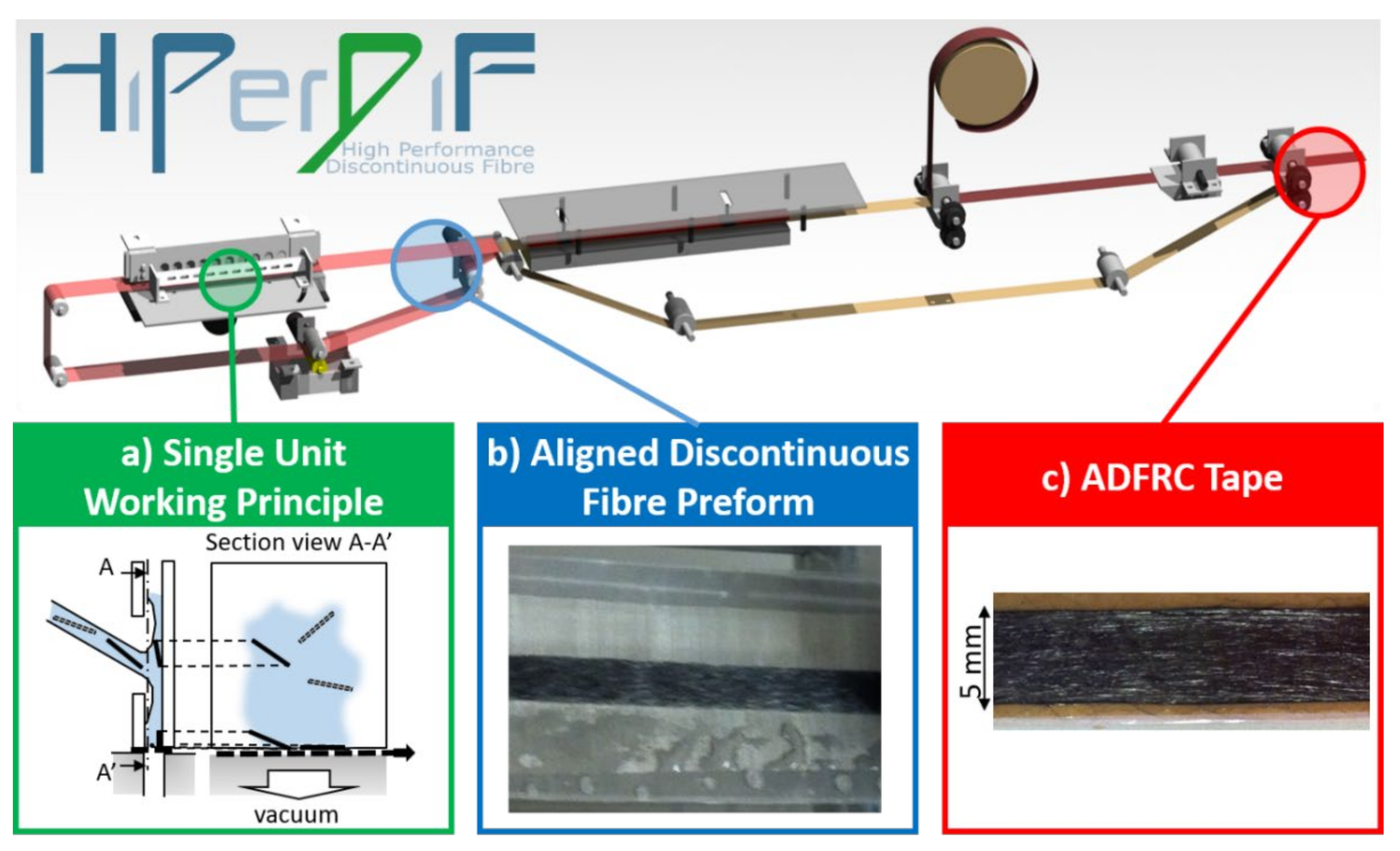
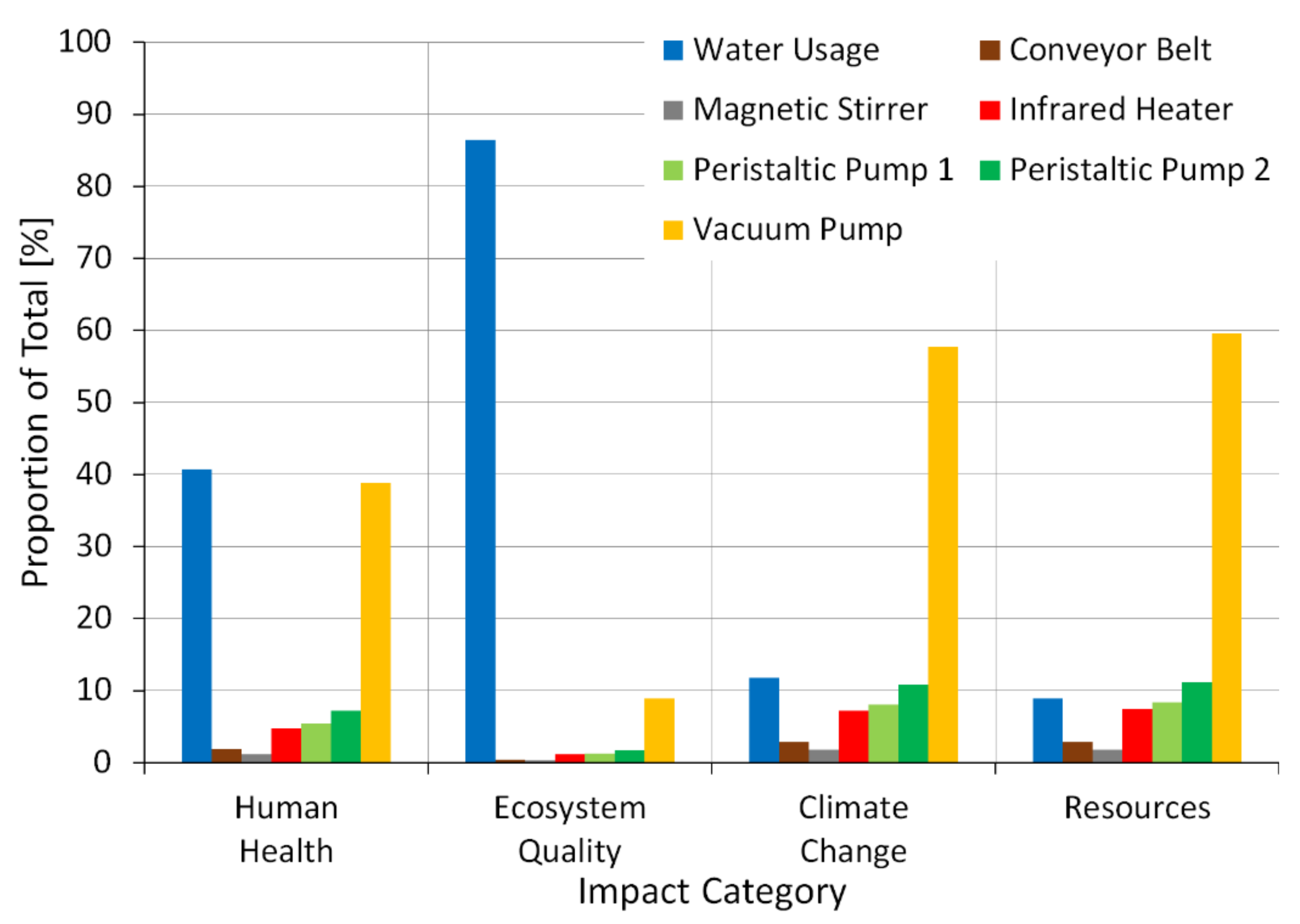
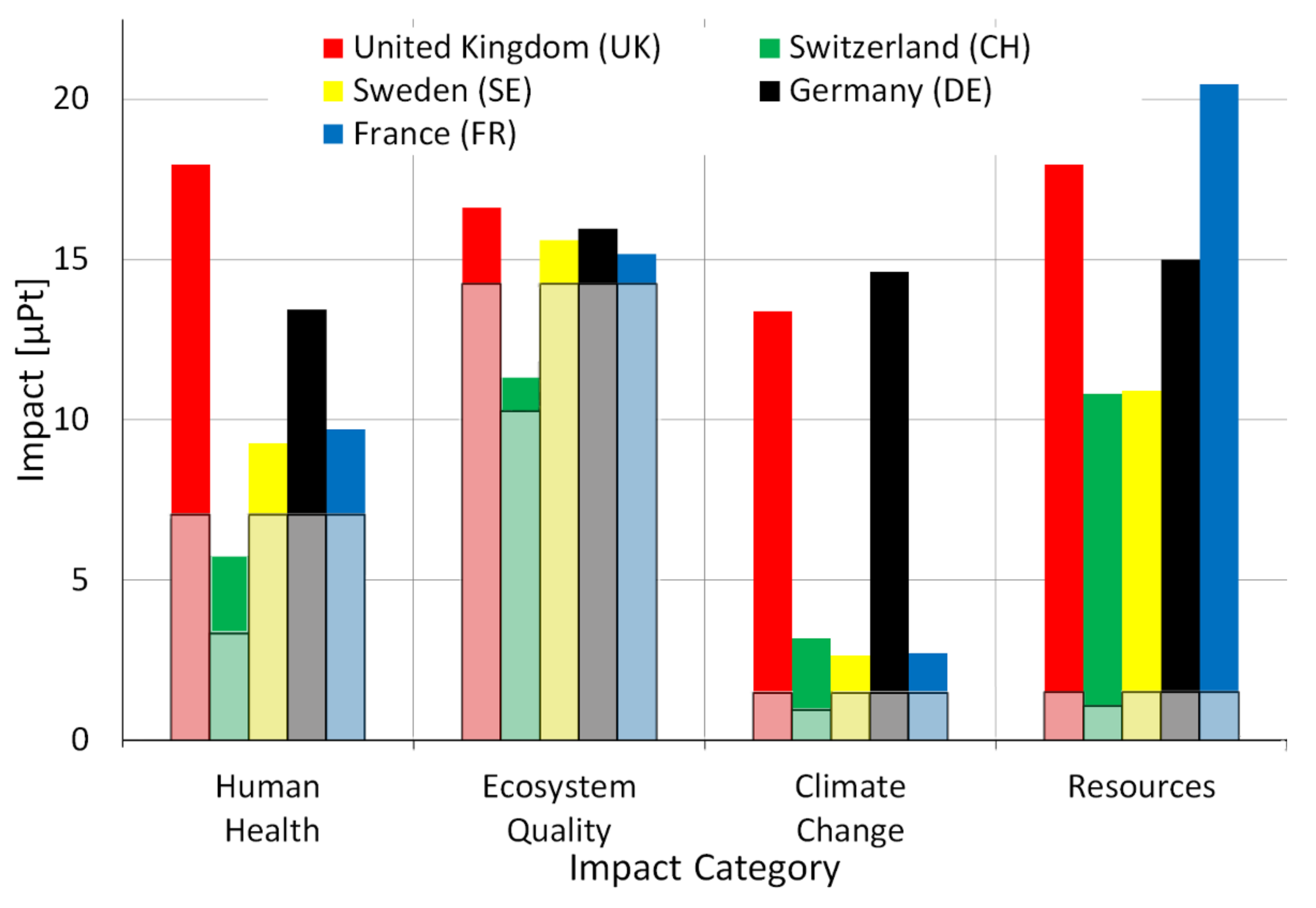


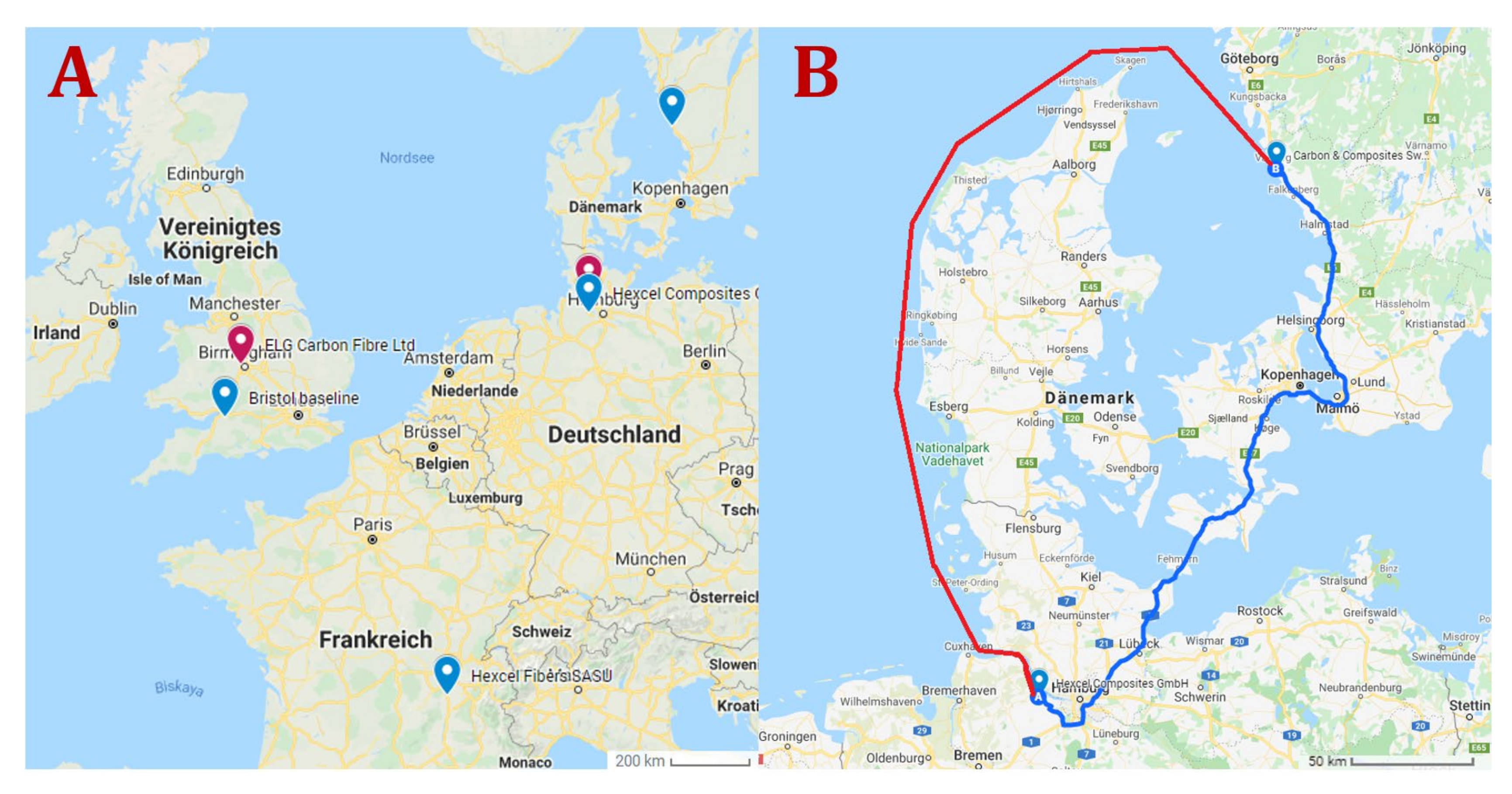
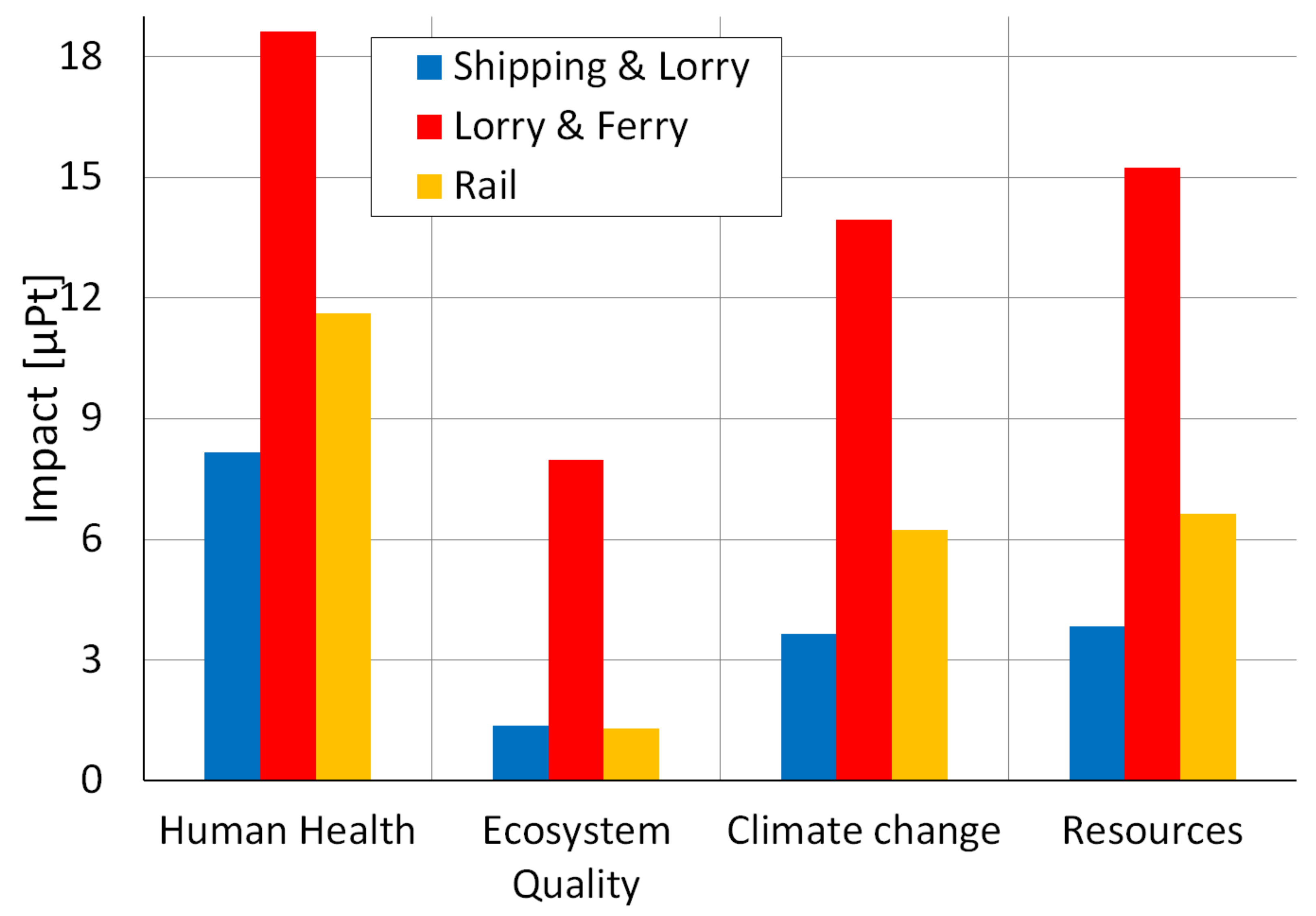
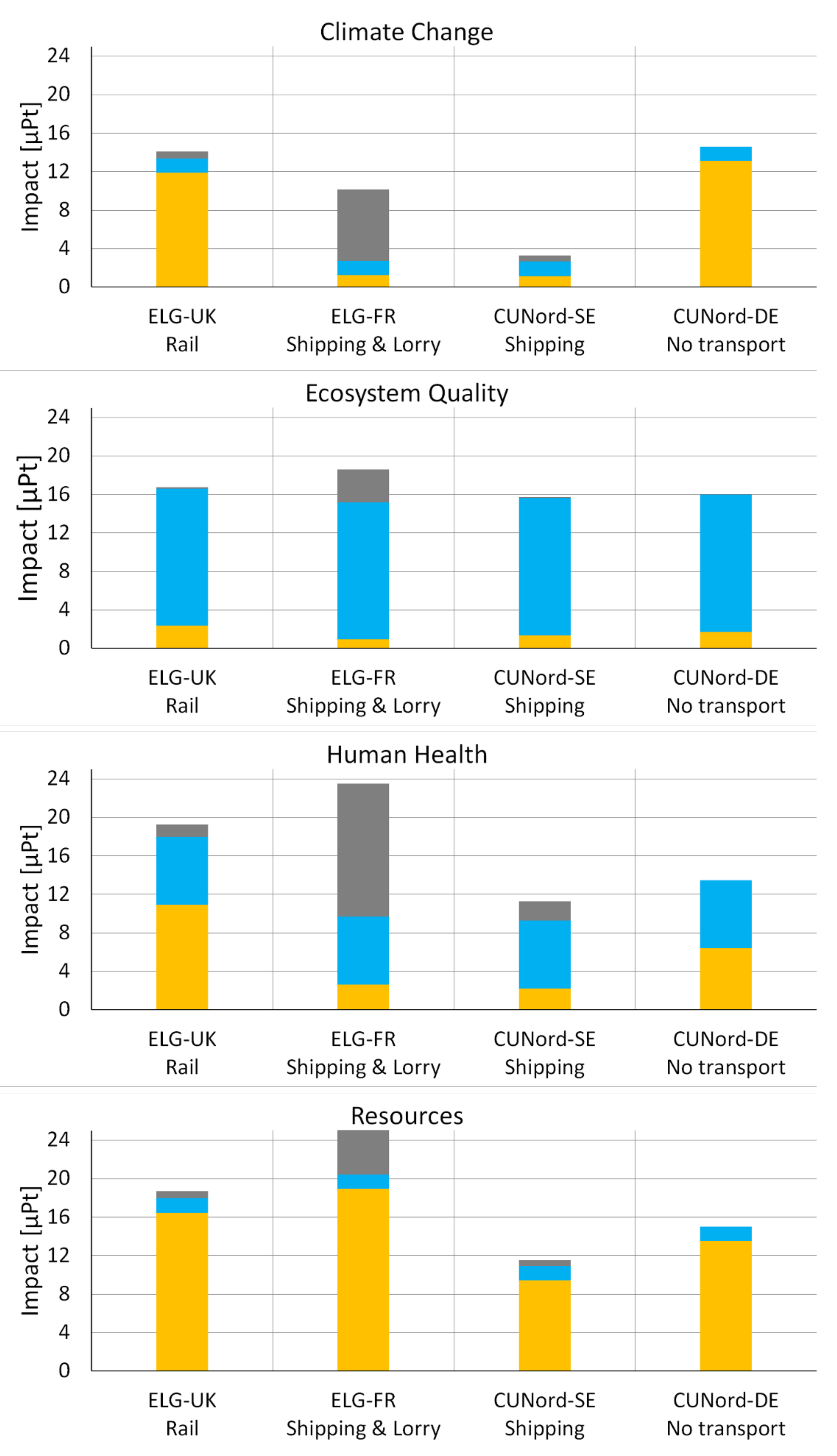
| Process | Appliance | Power Consumption (W) | Energy Demand (Wh/g) |
|---|---|---|---|
| Suspension agitation | Hot plate stirrer (x2) | 56 | 8.2 |
| Pump between tanks | Peristaltic pump I | 130 | 19.0 |
| Pump to alignment plates | Peristaltic pump II | 173 | 25.3 |
| Water recovery | Vacuum suction | 928 | 135.7 |
| Fibre movement | Conveyor belt | 45 | 6.6 |
| Fibre preform drying | Infrared heater | 115 | 16.8 |
| To: HiPerDiF Remanufacturing Destination | ||||||||||||||
|---|---|---|---|---|---|---|---|---|---|---|---|---|---|---|
| Bristol, UK | Rousillon, FR | Stade, DE | Varberg, SE | |||||||||||
| Scenario | 1 | 2 | 1 | 2 | 1 | 2 | 3 | 1 | 2 | |||||
| From: Reclamation origin point | ELG, Birmingham UK | Lorry | 145 | 1162 | 407 | 1065 | 145 | 1608 | 315 | |||||
| Ferry | 45 | 67 | 67 | |||||||||||
| Rail | 150 | 1327 | ||||||||||||
| Shipping | 1876 | 1565 | 1135 | |||||||||||
| CED (GJ) | 0.317 | 0.122 | 2.55 | 1.22 | 2.27 | 1.08 | 0.593 | 3.53 | 0.889 | |||||
| CFK Valley, Stade DE | Scenario | 1 | 2 | 3 | 1 | 2 | 3 | 1 | 1 | 2 | 3 | |||
| Lorry | 1032 | 1190 | 260 | 689 | 391 | |||||||||
| Ferry | 67 | 128 | ||||||||||||
| Rail | 1294 | 1792 | ||||||||||||
| Shipping | 1565 | 4365 | 546 | |||||||||||
| CED (GJ) | 2.27 | 1.06 | 0.276 | 2.6 | 1.46 | 1.34 | 0 | 1.51 | 0.855 | 0.0962 | ||||
Publisher’s Note: MDPI stays neutral with regard to jurisdictional claims in published maps and institutional affiliations. |
© 2022 by the authors. Licensee MDPI, Basel, Switzerland. This article is an open access article distributed under the terms and conditions of the Creative Commons Attribution (CC BY) license (https://creativecommons.org/licenses/by/4.0/).
Share and Cite
Fitzgerald, A.M.; Wong, N.; Fitzgerald, A.V.L.; Jesson, D.A.; Martin, F.; Murphy, R.J.; Young, T.; Hamerton, I.; Longana, M.L. Life Cycle Assessment of the High Performance Discontinuous Fibre (HiPerDiF) Technology and Its Operation in Various Countries. Sustainability 2022, 14, 1922. https://doi.org/10.3390/su14031922
Fitzgerald AM, Wong N, Fitzgerald AVL, Jesson DA, Martin F, Murphy RJ, Young T, Hamerton I, Longana ML. Life Cycle Assessment of the High Performance Discontinuous Fibre (HiPerDiF) Technology and Its Operation in Various Countries. Sustainability. 2022; 14(3):1922. https://doi.org/10.3390/su14031922
Chicago/Turabian StyleFitzgerald, Amy M., Nathan Wong, Annabel V. L. Fitzgerald, David A. Jesson, Ffion Martin, Richard J. Murphy, Tim Young, Ian Hamerton, and Marco L. Longana. 2022. "Life Cycle Assessment of the High Performance Discontinuous Fibre (HiPerDiF) Technology and Its Operation in Various Countries" Sustainability 14, no. 3: 1922. https://doi.org/10.3390/su14031922
APA StyleFitzgerald, A. M., Wong, N., Fitzgerald, A. V. L., Jesson, D. A., Martin, F., Murphy, R. J., Young, T., Hamerton, I., & Longana, M. L. (2022). Life Cycle Assessment of the High Performance Discontinuous Fibre (HiPerDiF) Technology and Its Operation in Various Countries. Sustainability, 14(3), 1922. https://doi.org/10.3390/su14031922











